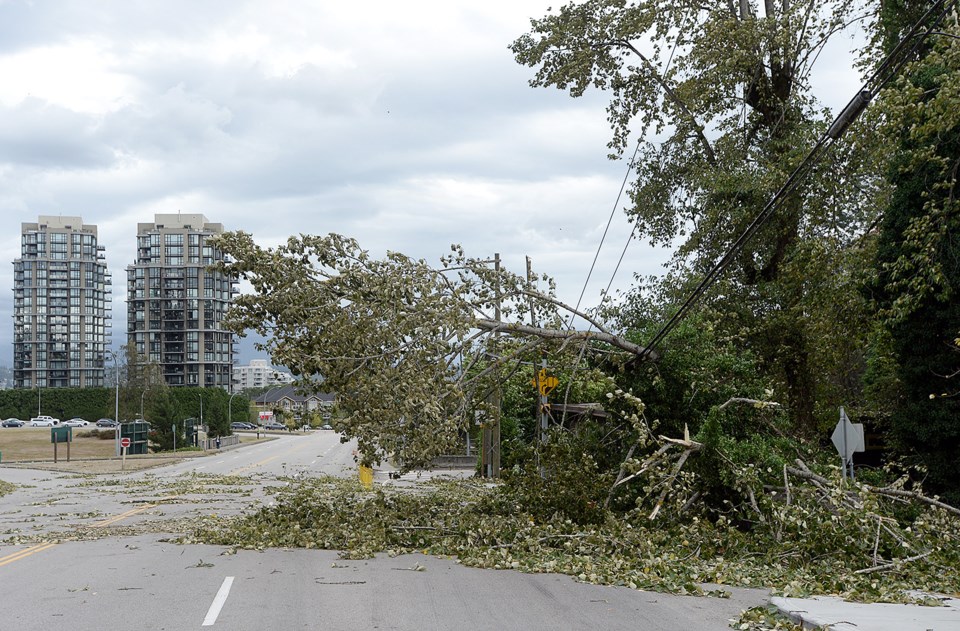While B.C. Hydro crews were run off their feet restoring power to homes and businesses throughout Metro Vancouver in the wake of Saturday’s massive wind storm, city crews were charged with the task of restoring most of the power in New Westminster.
The City of New Westminster is unique in that it owns and operates its own electrical utility, and distributes electricity to residential and commercial customers.
“Our crews will do 90 per cent of the work,” said Fire Chief Tim Armstrong. “Some of the high-tension lines coming in, some of the high-voltage lines in the substations are dealt with through B.C. Hydro. One of the real benefits of New Westminster is that we do have our own electrical utility. Our priority is New Westminster and getting it back up and running, whereas Hydro is doing the same thing on a regional level. They have the whole Lower Mainland or province to deal with in a big event or a storm, so we are kind of unique in that way that we have that expertise in the city.”
Armstrong told the Record about 25 per cent of New Westminster households were without power at one point on Saturday. Areas such as Sapperton, Stewardson Way, Royal Avenue and Queens Avenue were particularly hard hit, but many smaller areas were also without power.
“Trees were taking out wires. We had a number of calls where trees were still on wires, they had energized the ground. We had the risk of electrocutions through the ground so we had to protect those areas and maintain safety at those areas,” Armstrong said. “We had calls backing up, backing up so we had to bring in additional staff.”
Mayor Jonathan Cote think the city did an excellent job considering the difficult situation posed by the massive windstorm.
“Certainly, having our own electrical utility meant we were able to be a lot more reactive,” he told the Record. “Although we had some significant delays, I think if you compare us to neighbouring municipalities in Metro Vancouver we actually fared much better.”
Cote noted that the vast majority of the city had power by late Saturday, whereas the rest of the region still had significant power outages, even into Day 2.
According to B.C. Hydro, Saturday’s storm was one of the biggest ever to hit Metro Vancouver, with about 530,000 customers losing power on Saturday. As of 10 a.m. on Monday, about 48,000 B.C. Hydro customers were still without power.
Armstrong said the city called in extra police officers and firefighters to safeguard areas where there was a public safety risk because of electrified wires. With the city inundated about calls related to the storm, Armstrong activated the emergency operations centre (EOC) about noon on Aug. 29.
“We had trees that had come down on cars, we had quite a few in the Queensborough area along South Dyke Road. One person was hit by a tree and was injured,” Armstrong told the Record. “We had over 200 calls in a six-hour period.”
Armstrong, director of the city’s emergency operations centre, said the city was experiencing a much higher call volume than normal.
“It was really overwhelming all our resources here in the city,” he said. “It was my thought to bring all the key players together in the EOC to start prioritizing our responses.”
Key members of fire, police, electrical, engineering operations and parks departments were among the departments who gathered at the EOC in the Glenbrook fire hall.
“We had a lot of downed power lines – many,” Armstrong said. “Royal Columbian Hospital was impacted so we were worried about that. The main feed into that was compromised by a tree that had come down just near Sherbrooke Street.”
Working together at the emergency operations centre, city staff tried to get a picture of what power lines were down and which areas that were without power. The first priority was ensuring critical infrastructure, such as city buildings and care facilities, had electricity.
“Royal Columbian wasn’t impacted,” Armstrong said. “They have backup power and they have two main feeds to the hospital – if one goes down, they have a backup feed to deal with the issue. There was a high voltage coming into the hospital. They were going to have to disconnect the power there. That was something that B.C. Hydro was going to need to handle.”
Armstrong provided the city’s communications department with updates, which was posted on the city’s website. The city, along with the mayor and some councillors, posted information via Facebook and Twitter.
In addition to being “a really good learning experience for city staff” and providing a test of the emergency operations centre, Armstrong said the windstorm also served a wakeup call for residents about the need to have emergency kits so they’re prepared to get by on their own for 72 hours after a disaster.
“Certainly it is all hands on deck to clean that up,” Cote said of the cleanup. “We are working through all of the down trees and have a priority list based on road blockages and public safety. It is going to take us some time to work through that list but we are certainly hoping over the next week or two to have the majority of damage cleaned up.”

